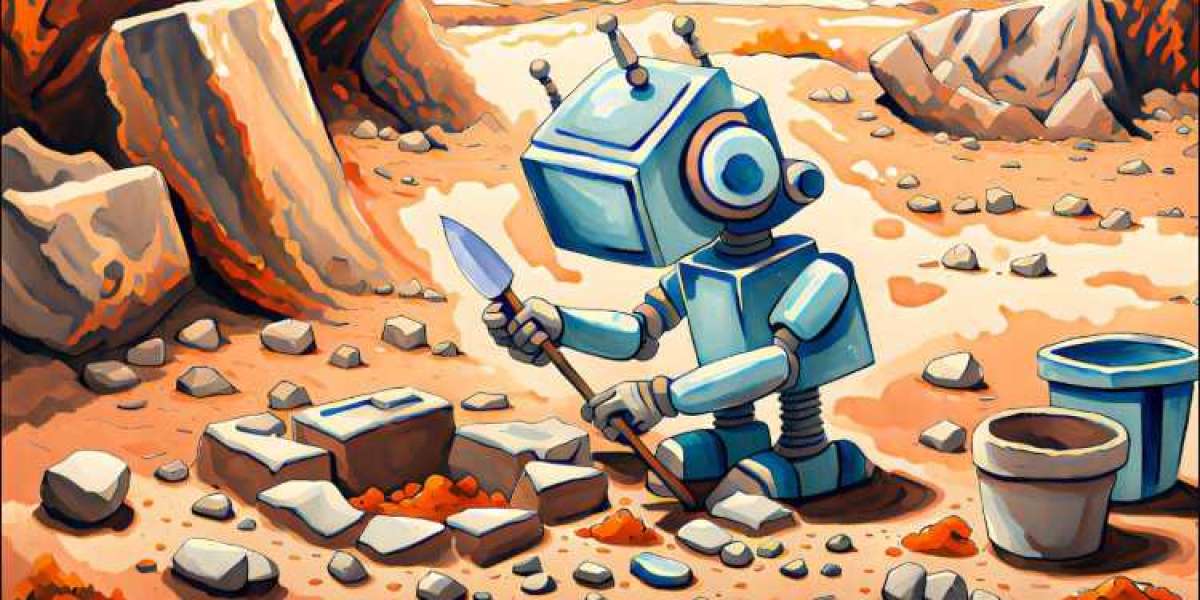Archaeology, the study of human history through the excavation and analysis of artifacts, has always been a meticulous and time-consuming endeavor. Over the years, traditional tools like shovels, brushes, and trowels have given way to advanced technologies, reshaping the field entirely. Among these innovations, artificial intelligence (AI) stands out as a revolutionary force, unlocking new possibilities for unearthing the secrets of the past.
In this blog, we explore how AI is transforming archaeology, from automating excavation processes to reconstructing ancient civilizations, and its profound impact on understanding human history.
The Role of AI in Modern Archaeology
AI in archaeology leverages machine learning, computer vision, and big data analytics to process vast amounts of information efficiently. It can analyze patterns, predict outcomes, and automate tasks, enabling archaeologists to focus on interpretation and discovery. Here are some key applications:
Site Detection and Mapping
Traditional archaeological surveys often require months or even years to identify potential excavation sites. AI, combined with satellite imagery and LiDAR (Light Detection and Ranging), has drastically sped up this process. Algorithms can analyze topographical data to detect subtle changes in terrain that indicate buried structures or artifacts. For instance, AI-driven LiDAR analysis has uncovered thousands of previously unknown structures in dense forests, such as Mayan ruins in Central America.
Artifact Recognition and Classification
Sorting and cataloging artifacts is a labor-intensive process. Machine learning algorithms trained on extensive databases of images can now identify and classify artifacts with remarkable accuracy. By recognizing patterns in pottery shards, tools, or sculptures, AI helps archaeologists date objects and determine their cultural significance.
Predictive Modeling
AI can predict where undiscovered sites might be located based on historical and environmental data. These predictive models consider factors like proximity to water sources, soil composition, and historical records, guiding archaeologists to high-potential areas.
Reconstruction of Artifacts and Sites
Broken or incomplete artifacts can now be virtually reconstructed using AI. Advanced algorithms analyze fragments and piece them together digitally, creating 3D models that reveal their original form. Similarly, AI is used to reconstruct entire buildings and settlements, offering insights into architectural styles and daily life.
Deciphering Ancient Texts
Many ancient scripts remain undeciphered or partially understood. AI is proving instrumental in cracking these codes. By analyzing linguistic patterns, grammar, and syntax, algorithms can translate ancient texts and inscriptions. Google's DeepMind, for example, has collaborated with researchers to decipher Linear B, an ancient Greek script.
Analyzing Burial Sites
AI aids in studying human remains, providing insights into ancient health, diets, and burial practices. Machine learning models analyze skeletal data to determine age, gender, and even causes of death, helping researchers build a comprehensive picture of past societies.
Real-World Examples of AI in Archaeology
Angkor Wat, Cambodia:
AI-powered LiDAR systems helped uncover an extensive network of roads, canals, and previously unknown temples surrounding the Angkor Wat complex. This discovery has transformed our understanding of the Khmer Empire and its urban planning.
Pompeii, Italy:
AI tools have been used to analyze graffiti and inscriptions preserved in the volcanic ash of Pompeii. These analyses offer a glimpse into the daily lives, social hierarchies, and political dynamics of the ancient Roman city.
Peru's Nazca Lines:
Researchers used machine learning to identify previously unknown geoglyphs etched into the Peruvian desert. These newfound designs add to the rich tapestry of the Nazca culture and their enigmatic artistic expressions.
Stonehenge, England:
AI has contributed to studying the landscape around Stonehenge, revealing hidden features like burial mounds, ditches, and pathways. These discoveries provide context for the monument's construction and its significance to Neolithic communities.
Benefits of AI in Archaeology
The integration of AI into archaeology offers numerous advantages:
Efficiency:
Tasks that once took months can now be accomplished in days, allowing archaeologists to focus on deeper analysis and interpretation.
Preservation:
Virtual reconstructions and digital databases ensure that artifacts and sites are preserved for future generations, even if the physical locations are threatened by climate change or urbanization.
Accessibility:
AI democratizes archaeology by making data and discoveries accessible to scholars worldwide. Digital archives and virtual tours allow researchers to study sites remotely, breaking down geographical barriers.
Cost-Effectiveness:
Automating processes reduces the need for large teams and expensive equipment, making archaeological projects more feasible.
New Discoveries:
AI's ability to analyze vast datasets uncovers patterns and connections that might otherwise go unnoticed, leading to groundbreaking discoveries.
Challenges and Ethical Considerations
While the benefits are immense, the use of AI in archaeology is not without challenges:
Data Bias:
AI algorithms are only as good as the data they are trained on. Biased or incomplete datasets can lead to inaccurate interpretations.
Loss of Traditional Skills:
The reliance on technology may lead to a decline in traditional archaeological skills, such as manual excavation and artifact analysis.
Ownership and Access:
Digital records raise questions about ownership and access. Who should control these datasets, and how should they be shared?
Misuse of Technology:
The commercialization of AI tools could prioritize profit over preservation, potentially leading to unethical practices, such as looting or unauthorized excavations.
Over-Reliance on Technology:
Archaeology is as much about interpretation as it is about discovery. Over-reliance on AI could risk oversimplifying the nuanced understanding of human history.
The Future of AI in Archaeology
The future of AI in archaeology is both exciting and promising. As technology continues to advance, we can expect:
Integration with Virtual Reality (VR):
Combining AI with VR will allow for immersive experiences, enabling researchers and the public to "walk through" ancient cities or observe artifacts in their original context.
Improved Algorithms:
Advances in machine learning and natural language processing will make AI even more adept at analyzing complex datasets and deciphering ancient texts.
Collaborative Platforms:
Cloud-based platforms will enable archaeologists from around the world to collaborate on projects, sharing data and insights in real time.
Sustainability:
AI-driven monitoring systems can help protect archaeological sites from threats like climate change, vandalism, and urban encroachment.
Interdisciplinary Approaches:
AI will continue to bridge the gap between archaeology and other disciplines, such as biology, anthropology, and history, fostering a more holistic understanding of the past.
Conclusion
AI is revolutionizing archaeology, offering tools and techniques that were once the stuff of science fiction. By automating processes, analyzing vast datasets, and uncovering hidden patterns, AI enables archaeologists to delve deeper into the mysteries of human history. However, as we embrace these advancements, it is crucial to address the ethical and practical challenges they bring.
In the end, AI is not replacing archaeologists but empowering them. It serves as a powerful ally in the quest to uncover the stories of our ancestors, ensuring that the lessons of the past continue to illuminate our future. The digital age has truly opened a new chapter in the timeless tale of human discovery.














